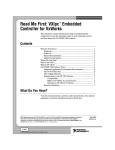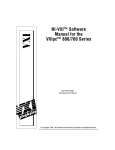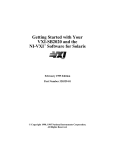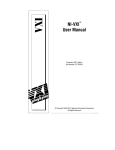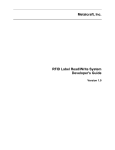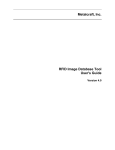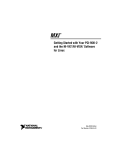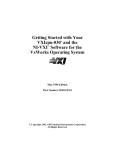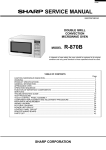Download Read Me First: VXIpc Embedded Controller for VxWorks
Transcript
READ ME FIRST: VXIPC ™ EMBEDDED CONTROLLER
FOR VXWORKS
This document contains information to help you understand the
components of your kit, determine where to start setting up your kit,
and learn about the NI-VXI/NI-VISA features.
Contents
What Do You Have? ............................................................................... 2
Hardware.......................................................................................... 2
Software ........................................................................................... 2
Printed Documentation .................................................................... 2
Online Documentation ..................................................................... 3
Where Do You Start?.............................................................................. 3
What Is NI-VXI?..................................................................................... 5
What Is NI-VISA? .................................................................................. 5
NI-VXI/NI-VISA Release Notes ............................................................ 6
Supported Application Development Environments ....................... 6
The NI-VXI Directory ..................................................................... 6
The VXIpnp Directory..................................................................... 6
Enhancements to the NI-VXI Software ........................................... 7
Compatibility ............................................................................ 7
High-Level VXIbus Access Functions ..................................... 7
Interrupts in NI-VXI for VxWorks........................................... 7
Remote Controllers .......................................................................... 7
MXI™, National Instruments™, NI™, NI-488.2™, ni.com™, NI-VISA™, NI-VXI™, and VXIpc™ are trademarks of
National Instruments Corporation. Product and company names mentioned herein are trademarks or trade names of
their respective companies. For patents covering National Instruments products, refer to the appropriate location:
Help»Patents in your software, the patents.txt file on your CD, or ni.com/patents.
ni.com
© 1997–2002 National Instruments Corp. All rights reserved.
May 2002
321847E-01
What Do You Have?
Your kit contains hardware, software, and documentation. You may also
have ordered some optional equipment or software.
Hardware
Your hardware includes either the VXIpc 800 Series or the
VXIpc 700 Series controller, which you install in your VXI mainframe.
You also receive the following accessories:
•
8 in. serial conversion cable (available for the VXIpc 800 Series only)
•
Electromagnetic emissions kit
•
AT-PS/2 cable
Software
Your VXIpc kit contains the following software components:
•
Host-Side Software for VXIpc with VxWorks (Microsoft Windows
Installation)
•
Target-Side Software for VXIpc with VxWorks
For your convenience, NI-VXI/NI-VISA, NI-488.2, and a VxWorks boot
ROM loader (bootrom.sys) are already installed on the hard drive of your
VXIpc embedded controller.
Printed Documentation
Aside from this document, your kit contains the following printed manuals:
•
Getting Started with Your VXIpc Controller for VxWorks contains an
overview of the VXIpc hardware and the NI-VXI software, guides you
through setting up your kit, and helps you get started with application
development. You can also use this manual as a reference for the
hardware and software default settings, to find the answers for
commonly asked questions, and for information on reinstalling the
software, if necessary.
•
The VXIpc 770/870B Series User Manual (in VXIpc 770/870B Series
kits), VXIpc 870 Series User Manual (in VXIpc 870 kits), VXIpc 800
Series User Manual (in VXIpc 800 kits), or VXIpc 700 Series User
Manual (in VXIpc 700 kits) contains information on configuring and
installing your VXIpc controller. You may not need this manual if you
are performing a simple hardware installation that uses the standard
default settings. However, you should keep this manual in case you
VXIpc Embedded Controller for VxWorks
2
ni.com
decide to try a different switch or jumper setting at a later time.
The user manual also contains information on BIOS, the front panel
and connectors, the LEDs, and system resources.
Online Documentation
Your kit includes links to online manuals—Adobe Acrobat portable
document format (PDF) files. This online documentation is installed by
the Host-Side Software with VXIpc with VxWorks setup software and is
intended for use on the Microsoft Windows operating systems. You can
view these manuals online, navigate through them, and print them from
your computer using the Adobe Acrobat Reader.
The National Instruments manuals in PDF format are as follows:
•
The NI-VXI User Manual describes the features and concepts of
the NI-VXI software and explains how to use NI-VXI in your
application.
•
The NI-VXI Programmer Reference Manual describes in detail the
VXI/VME function calls in the C/C++ and BASIC languages.
•
The NI-VXI Text Utilities Reference Manual describes in detail the
interactive text utilities for the NI-VXI software.
•
The NI-VISA User Manual describes how to program using VISA.
•
The NI-VISA Programmer Reference Manual describes in detail the
attributes, events, and operations you use in NI-VISA.
•
The GPIB Reference Manual for VXIpc Embedded Controllers
and VxWorks contains information about using NI-488.2 on your
VXIpc controller with the VxWorks operating system.
To access these manuals, the NI-VXI and NI-VISA function references,
and the ReadMe files, follow the links in the appropriate HTML file in
your Board Support Package (BSP). The files you use to access the
online manuals are manuals-vxi.html, manuals-visa.html,
and manuals-gpib.html. See step 3 in the Where Do You Start?
section for more information on the BSP.
Where Do You Start?
1.
Compare your kit contents with the description in the What Do You
Have? section. Contact National Instruments regarding any
discrepancies.
2.
VxWorks uses a target and host machine. If you are unfamiliar with
this concept, refer to the Developing for VxWorks section in Chapter 1,
Introduction, of Getting Started with Your VXIpc Embedded
© National Instruments Corporation
3
VXIpc Embedded Controller for VxWorks
Controller for VxWorks (hereafter referred to as your getting started
manual).
3.
The following steps assume that Tornado, the VxWorks host-side
development environment, is already installed on your host computer.
Run the Setup program from the Host-Side Software with VXIpc with
VxWorks installation disk to install the software. This disk is intended
for Windows host machines. For a first time installation, we
recommend you install all the software, which contains the VxWorks
Board Support Package (BSP), the VXI/VME and GPIB driver
component software, NI-VISA support for VxWorks, online help,
examples, and header files for NI-VXI, NI-VISA, and NI-488.2.
Note The current version of the VXIpc BSP requires Tornado II. If you have an earlier
version of Tornado, contact Wind River for an upgrade.
4.
Refer to the Using the VXIpc Board Support Package to Create the
VxWorks Operating System section in Chapter 1, Introduction, of
your getting started manual. This section contains information about
building the VxWorks operating system, which will run on the VXIpc,
using the VXIpc Board Support Package (BSP). This section also
contains information about configuring the VXIpc BSP.
5.
On the target side, your VXIpc should have the NI-VXI, NI-VISA,
and NI-488.2 software already installed, along with a working
bootrom.sys file to help you get started.
•
If you need to reinstall this software for any reason, use the disks
labeled Target-Side Software for VXIpc with VxWorks. You can
also refer to the Reinstalling the NI-VXI Software section in
Chapter 1, Introduction, of your getting started manual.
•
A working bootrom.sys is included on the target-side software
disks, should it become necessary to reinstall that component.
6.
Most VXI/VME features on the VXIpc controller are configurable
through software. Use the vxitedit configuration utility in the NI-VXI
software if you want to change any of the options from their default
settings. Run Resman to set up your VXI system and victext to verify
the system configuration.
7.
After you finish setting up your system, refer to the following
documents to learn how to use VXI/VME or GPIB.
•
Refer to Chapter 4, Developing Your Application, in your getting
started manual to learn how to use your VXI/VME system and
ensure it is operating properly.
•
Refer to Chapter 2, Developing Your Application with the
VxWorks Drivers, in the GPIB Reference Manual for VXIpc
Embedded Controllers and VxWorks, to learn how to use the
VXIpc Embedded Controller for VxWorks
4
ni.com
VxWorks GPIB drivers and how to develop a GPIB application
using the NI-488.2 API.
•
8.
Refer to Chapter 3, VISA Overview, in the NI-VISA User Manual,
for information about programming with VISA. Use the Acrobat
Reader to view this manual online.
Refer to the README.TXT files for important information that may
affect your application program, including known issues and software
corrections with this release and additional information relevant to API
development.
You can access the README.TXT files where you installed the software
for VxWorks on your host machine. There are separate README files
for several of the components.
You can also reference the National Instruments Web sites ni.com
or ftp.ni.com for driver updates, examples, and product news.
What Is NI-VXI?
The NI-VXI system-level software is the driver that controls your
VXIpc and VXI/VME system. NI-VXI includes a Resource Manager,
an interactive configuration program, libraries of software routines for
test and measurement programming, and an interactive control program.
You can use this software to seamlessly program multiple-mainframe
configurations and ensure software compatibility across a variety of
controller platforms.
What Is NI-VISA?
VISA is a standard I/O Application Programming Interface (API) for
instrumentation programming. In VxWorks, VISA by itself does not
provide any instrumentation programming functionality. VISA is a
high-level API that calls into system-level drivers. As an example, the
NI-VISA implementation of VISA uses the NI-VXI system-level driver
for National Instruments VXI controllers.
In its full implementation, VISA can control VXI, PXI, GPIB, TCP/IP,
or Serial instruments, making the appropriate driver calls depending on
the type of instrument being used. VISA uses the same operations to
communicate with instruments regardless of the interface type. For
example, the VISA command to write an ASCII string to a message-based
instrument is the same whether the instrument is Serial, GPIB, or VXI.
As a result, VISA gives you interface independence. This makes it easier to
switch bus interfaces and means that users who must program instruments
for multiple interfaces need learn only one API. This release of NI-VISA
for VxWorks provides the VXI and Serial portions of the API and is
© National Instruments Corporation
5
VXIpc Embedded Controller for VxWorks
compatible with VISA programs written for those interfaces on other
platforms.
Another advantage of VISA is that it is an object-oriented API that will
easily adapt to new instrumentation interfaces as they evolve, making
application migration to the new interfaces easy.
Because VISA is the industry standard for developing instrument drivers,
most instrument drivers currently written by National Instruments use
VISA and therefore support VxWorks, Windows, Solaris, Linux, and
Macintosh, if the system-level drivers are available for that platform.
NI-VXI/NI-VISA Release Notes
This section describes the new utilities and features in this release of
NI-VXI/NI-VISA for VxWorks.
Supported Application Development Environments
This release of NI-VXI/NI-VISA for VxWorks supports the Tornado
gcc compiler version 2.7. Other Application Development Environments
(ADEs) or a later version of this ADE may also work.
The NI-VXI Directory
The nivxi directory on your VXIpc hard drive contains important files
that describe the configuration of your hardware and software. By default,
the library searches for these files in the directory /ide0/nivxi, which
corresponds to C:\NIVXI in MS-DOS and means that the nivxi directory
must be at the root level of the hard drive. If you must move or rename the
directory, use the environmental variable NIVXIPATH to inform the library
of the new location. The VxWorks method for setting an environment
variable uses the putenv("variableName=value") function. For
example, to instruct the library to search for the NI-VXI files in a
subdirectory of your NI-VXI directory, your function syntax would be
putenv("NIVXIPATH=/ide0/nivxi/vxworks").
The VXIpnp Directory
The vxipnp directory on your VXIpc hard drive, like the nivxi
directory, contains important information used by NI-VISA. If the
files in that location (/ide0/vxipnp) are not available, VISA will
not work. To instruct the library to search for the NI-VISA files in a
different location, use the putenv syntax described above; for example,
to use a floppy disk for your VXIpnp directory, your function syntax would
be putenv("VXIPNPPATH=/fd0/vxipnp/").
VXIpc Embedded Controller for VxWorks
6
ni.com
Enhancements to the NI-VXI Software
The following sections describe the additional options beyond what is
documented in the NI-VXI User Manual and the NI-VXI Programmer
Reference Manual.
Compatibility
NI-VXI applications that follow the guidelines documented in the
NI-VXI User Manual will work with NI-VXI for the VXIpc embedded
controllers with VxWorks.
High-Level VXIbus Access Functions
For best performance, keep the following in mind when using VXImove():
or viMove.
•
Make sure your buffers are 32-bit aligned.
•
Transfer 32-bit data whenever possible.
•
Use VXI block access privileges to significantly improve performance
to devices that can accept block transfers.
Interrupts in NI-VXI for VxWorks
To provide real-time performance, NI-VXI event handlers in VxWorks
behave differently than those in other operating systems. When you install
a handler for a VXI event such as an interrupt, trigger, or signal, and the
appropriate event occurs, the interrupt service routine (ISR) executes your
code. The context for the ISR is independent of any task and has certain
restrictions regarding what operating system functions may be used
because, for the duration of the ISR, no normal task will execute. For
example, you may not attempt to acquire a semaphore (semTake) in the
ISR. Refer to your VxWorks reference manuals for details on functions
which may not be executed in the ISR. If your application requires a
function with this restriction, or performs other complex or
time-consuming operations, you may want to consider using a signal or
a semaphore to alert a “worker” task which will respond to the interrupt
outside of the ISR. The worker task can be given high priority, if needed,
to ensure optimal performance.
Remote Controllers
This section applies to multiframe systems where you use interrupts,
triggers, or utility bus signals.
Remote controllers, when configured to detect asynchronous events such
as a VXI interrupt or VXI trigger, need to inform the local controller that
such an asynchronous event has occurred. The remote controllers report
© National Instruments Corporation
7
VXIpc Embedded Controller for VxWorks
these events back to the local controller via a VXI IRQ line. This IRQ line
is called the system IRQ line. You can use vxitedit to select which VXI
interrupt line the remote controller uses to report remote events to the local
controller. Map the system IRQ line back to the local controller to receive
remote controller interrupts. The Resource Manager performs this mapping
automatically in the parent-side VXI-MXI-2 controllers, but not in other
mainframe extenders. You can map interrupts through vxitedit, or with the
MapVXIint() function, which is described in the NI-VXI online help or
the NI-VXI Programmer Reference Manual.
The system IRQ line is treated differently than other IRQ lines used by
NI-VXI:
•
The Resource Manager (Logical Address 0) always acknowledges the
system IRQ line.
•
You cannot disable the system IRQ line on the Resource Manager.
Calling DisableVXIint() on the system IRQ line does not disable it.
•
Devices other than remote controllers can also interrupt on the system
IRQ line, provided the device at Logical Address 0 is the handler for
the interrupt.
•
National Instruments recommends that you do not route the system
IRQ line to the signal queue. Because the system IRQ line cannot be
disabled, this routing could lose interrupts.
Passing the value –1 as the logical address of a controller in NI-VXI causes
NI-VXI to select the local controller. Notice that on external controllers
such as the PCI-MXI-2, –1 refers to the first remote controller in your
system. This is to maintain compatibility with older systems where the
external controller needed an extender to assert and receive interrupts.
*321847E-01*
321847E-01
May02








